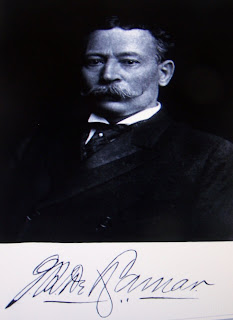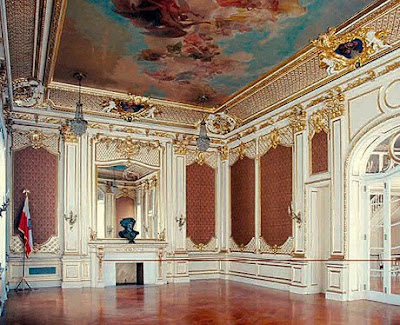233 Madison Ave at 37th St. (northeast corner)

Joseph De Lamar’s Beaux-Arts mansion at Madison Avenue and 37th Street is now the property of the Consulate General of the Republic of Poland. One of the most opulent gilded age mansions surviving in New York City, the stone residence was designed in 1902 by Charles Pierrepont Henry Gilbert (1860-1952), a society architect whose stock in trade was extravagant private mansions; his list of clients included the Woolworths. The De Lamar house, distinguished by a particularly colossal French mansard roof, was awarded New York City landmark status in 1975.
De Lamar, born in Amsterdam in 1843, left home as a youthful stowaway, but went on to become a Dutch ship captain. He later settled in Martha’s Vineyard, where he operated a marine salvage business. By the 1870s he fell victim to Gold Rush fever and become a speculator in metals in Colorado, where he soon made a $20 million fortune, mostly in copper. He served one term in the Senate of the Territory of Idaho, and a southern Idaho ghost town, De Lamar, is named after him. By the 1890s he was one of the wealthiest men in the United States.

He relocated to New York City, and after a divorce from his wife, a direct descendant of John Quincy Adams, De Lamar moved to Europe to educate his young daughter and collect art in Paris. Upon returning to New York he lived with his daughter and eleven servants in his new French mansion from 1906 until his death from pneumonia at seventy five years of age, in 1918. Although aloof and taciturn in his professional demeanor, he was an avid yachtsman and the life of the party among the New York City social elite. He commissioned a private manor house, “Pembroke” located in Glen Cove, Long Island, also designed by C. P. H. Gilbert (demolished in 1968).
See note at end of post.
By the time his fabulous Murray Hill residence was built, the neighborhood was past its prime, but he chose this location to taunt J. P. Morgan, who lived just one block south. De Lamar had approached Morgan on numerous occasions, seeking a business collaboration, but he had been rebuffed every time. To say that De Lamar’s house put Morgan’s to shame is extreme understatement. Madison Avenue, which did not open until 1836, was named both for the square where it starts and for former President James Madison, who died that year. This avenue was not included in the original 1811 plan of New York, which assumed that few people would want to live in the middle of Manhattan Island, far north of the commerce of the shoreline at Manhattan's southern tip.

The vastness of scale, its numerous parlors and elaborately designed and decorated rooms met all expectations for humiliating J. P. Morgan. The first floor housed an expansive dining room, library and a billiard room. The main oval staircase incorporated a fountain surrounded by exotic plants and marble figurines. The second floor boasted a ballroom, a concert hall, and an art gallery painted in Pompeiian red with Tiffany stained glass illuminated by electricity, which made this magnificent structure quite modern for its time (J. P. Morgan, founder of General Electric, had the first electrified private house in the city; electricity for Morgan was supplied by a power plant built in his garden by Thomas Edison). Above the fifth floor, behind a classical mansard roof, was a terrace which exists to the present day. Artist and decorator Louis Schaettle completed the interior design, including finely executed murals. It is amazing that so much opulence could be contained on a plot of land measuring only 50 by 100 feet, purchased for the then staggering sum of $250,000. De Lamar spent three times that amount to build his house.

An unusual feature was a large metal plate flush with the sidewalk along 37th Street. It is the roof of an elevator designed to lower a horse and carriage to the basement (later used for automobiles). These days it is used to receive freight and facilitate trash removal.
De Lamar’s obituary described him as a Wall Street “man of mystery” and mentioned that he was an accomplished organist. He left an estate worth at least $32 million. After a brief stint as offices of the American Bible Society, in 1923 the house became headquarters for the National Democratic Club for fifty years. The Polish government acquired the mansion in 1973 and has restored it from top to bottom.

The public may visit the extravagant second floor rooms for lectures and concerts sponsored by the Polish government. A concert series to inaugurate the Chopin Year Celebration begins with a piano and cello recital February 23, 2010. Click the following link for particulars and subsequent events.
www.polishconsulateny.org/index.php?p=267Note: Mr. De Lamar had one of the country’s finest residence pipe organs installed on the staircase landing at Pembroke, his Long Island waterfront estate in Glen Cove; he was himself an accomplished organist, a fact mentioned in his obituary published by the Boston Globe. In 1920 this 50-room mansion, also designed by Gilbert, was sold by De Lamar’s daughter to Marcus Loew, a founder of Metro-Goldwyn-Meyer. It was here that Elizabeth Taylor honeymooned with Richard Burton. De Lamar’s 47-acre Long Island estate had a palm court with a cave and waterfall, and all its "significant" windows were of stained-glass designed by Louis Comfort Tiffany. The basement contained a movie theater, squash court and shooting range. The house was demolished in 1968 by an owner who thought it too unwieldy; he built a new, much smaller house on the property.










